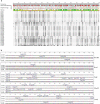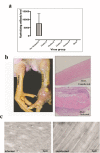Phenotypic, genotypic and antigenic characterization of emerging avian reoviruses isolated from clinical cases of arthritis in broilers in Saskatchewan, Canada
- PMID: 28620186
- PMCID: PMC5472580
- DOI: 10.1038/s41598-017-02743-8
Phenotypic, genotypic and antigenic characterization of emerging avian reoviruses isolated from clinical cases of arthritis in broilers in Saskatchewan, Canada
Abstract
In recent years, emerging strains of pathogenic arthrogenic avian reovirus (ARV) have become a challenge to the chicken industry across USA and Canada causing significant economic impact. In this study, we characterized emerging variant ARV strains and examined their genetic and antigenic relationship with reference strains. We isolated 37 emerging variant ARV strains from tendons of broiler chickens with clinical cases of arthritis/tenosynovitis at commercial farms in Saskatchewan, Canada. Viral characterization using immunocytochemistry, gold-immunolabeling and electron microscopy revealed distinct features characteristic of ARV. Polymerase chain reaction-restriction fragment length polymorphism (PCR-RFLP) analyses of the viral Sigma C gene revealed genetic heterogeneity between the field isolates. On phylogenetic analyses, the Sigma C amino acid sequences of the isolates were clustered into four distinct genotypic groups. These ARV field strains were genetically diverse and quite distant from the vaccine and vaccine related field strains. Antibodies produced against a commercial Reo 2177 ® vaccine did not neutralize these variants. Moreover, structure based analysis of the Sigma C protein revealed significant antigenic variability between the cluster groups and the vaccine strains. To the best of our knowledge, this is the first report on the genetic, phenotypic and antigenic characterization of emerging ARVs in Canada.
Conflict of interest statement
The authors declare that they have no competing interests.
Figures








Similar articles
-
Pathogenicity and genomic characterization of a novel avian orthoreovius variant isolated from a vaccinated broiler flock in China.Avian Pathol. 2019 Aug;48(4):334-342. doi: 10.1080/03079457.2019.1600656. Epub 2019 Apr 18. Avian Pathol. 2019. PMID: 30915860
-
Molecular characterization of emerging avian reovirus variants isolated from viral arthritis cases in Western Canada 2012-2017 based on partial sigma (σ)C gene.Virology. 2018 Sep;522:138-146. doi: 10.1016/j.virol.2018.06.006. Epub 2018 Jul 18. Virology. 2018. PMID: 30029013
-
Genetic characterization of newly emerging avian reovirus variants in chickens with viral arthritis/tenosynovitis in Israel.Virology. 2024 Jan;589:109908. doi: 10.1016/j.virol.2023.109908. Epub 2023 Oct 10. Virology. 2024. PMID: 37952464
-
Review of Viral Arthritis in Canada.Avian Dis. 2022 Dec;66(4):452-458. doi: 10.1637/aviandiseases-D-22-99997. Avian Dis. 2022. PMID: 36715479 Review.
-
Avian Orthoreoviruses: A Systematic Review of Their Distribution, Dissemination Patterns, and Genotypic Clustering.Viruses. 2024 Jun 29;16(7):1056. doi: 10.3390/v16071056. Viruses. 2024. PMID: 39066218 Free PMC article.
Cited by
-
Autophagy induced by avian reovirus enhances viral replication in chickens at the early stage of infection.BMC Vet Res. 2019 May 24;15(1):173. doi: 10.1186/s12917-019-1926-5. BMC Vet Res. 2019. PMID: 31126305 Free PMC article.
-
Pathogenicity of avian reovirus variant in the immune organs of broiler chicks.Virus Res. 2025 Mar;353:199538. doi: 10.1016/j.virusres.2025.199538. Epub 2025 Feb 6. Virus Res. 2025. PMID: 39909158 Free PMC article.
-
A Snapshot on the Genomic Epidemiology of Turkey Reovirus Infections, Hungary.Animals (Basel). 2023 Nov 13;13(22):3504. doi: 10.3390/ani13223504. Animals (Basel). 2023. PMID: 38003122 Free PMC article.
-
Characterization of Monoclonal Antibodies against σA Protein and Cross-Reactive Epitope Identification and Application for Detection of Duck and Chicken Reovirus Infections.Pathogens. 2019 Sep 7;8(3):140. doi: 10.3390/pathogens8030140. Pathogens. 2019. PMID: 31500272 Free PMC article.
-
Whole Genomic Constellation of Avian Reovirus Strains Isolated from Broilers with Arthritis in North Carolina, USA.Viruses. 2023 Oct 31;15(11):2191. doi: 10.3390/v15112191. Viruses. 2023. PMID: 38005869 Free PMC article.
References
-
- Lee LH, Wang YH, Shien JH. Serological characterization of reoviruses isolated from avian species in Taiwan. J. Chin. Soc. Vet. Sci. 1992;18:69–72.
Publication types
MeSH terms
Substances
LinkOut - more resources
Full Text Sources
Other Literature Sources
Medical

